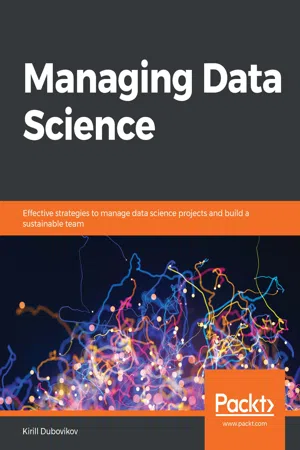
Managing Data Science
Effective strategies to manage data science projects and build a sustainable team
- 290 pages
- English
- ePUB (mobile friendly)
- Available on iOS & Android
Managing Data Science
Effective strategies to manage data science projects and build a sustainable team
About this book
Understand data science concepts and methodologies to manage and deliver top-notch solutions for your organization
Key Features
- Learn the basics of data science and explore its possibilities and limitations
- Manage data science projects and assemble teams effectively even in the most challenging situations
- Understand management principles and approaches for data science projects to streamline the innovation process
Book Description
Data science and machine learning can transform any organization and unlock new opportunities. However, employing the right management strategies is crucial to guide the solution from prototype to production. Traditional approaches often fail as they don't entirely meet the conditions and requirements necessary for current data science projects. In this book, you'll explore the right approach to data science project management, along with useful tips and best practices to guide you along the way.
After understanding the practical applications of data science and artificial intelligence, you'll see how to incorporate them into your solutions. Next, you will go through the data science project life cycle, explore the common pitfalls encountered at each step, and learn how to avoid them. Any data science project requires a skilled team, and this book will offer the right advice for hiring and growing a data science team for your organization. Later, you'll be shown how to efficiently manage and improve your data science projects through the use of DevOps and ModelOps.
By the end of this book, you will be well versed with various data science solutions and have gained practical insights into tackling the different challenges that you'll encounter on a daily basis.
What you will learn
- Understand the underlying problems of building a strong data science pipeline
- Explore the different tools for building and deploying data science solutions
- Hire, grow, and sustain a data science team
- Manage data science projects through all stages, from prototype to production
- Learn how to use ModelOps to improve your data science pipelines
- Get up to speed with the model testing techniques used in both development and production stages
Who this book is for
This book is for data scientists, analysts, and program managers who want to use data science for business productivity by incorporating data science workflows efficiently. Some understanding of basic data science concepts will be useful to get the most out of this book.
Frequently asked questions
- Essential is ideal for learners and professionals who enjoy exploring a wide range of subjects. Access the Essential Library with 800,000+ trusted titles and best-sellers across business, personal growth, and the humanities. Includes unlimited reading time and Standard Read Aloud voice.
- Complete: Perfect for advanced learners and researchers needing full, unrestricted access. Unlock 1.4M+ books across hundreds of subjects, including academic and specialized titles. The Complete Plan also includes advanced features like Premium Read Aloud and Research Assistant.
Please note we cannot support devices running on iOS 13 and Android 7 or earlier. Learn more about using the app.
Information
Section 1: What is Data Science?
- Chapter 1, What You Can Do with Data Science
- Chapter 2, Testing Your Models
- Chapter 3, Understanding AI
What You Can Do with Data Science
- Defining AI
- Introduction to machine learning
- Introduction to deep learning
- Deep learning use case
- Introduction to causal inference
Defining AI
Defining data science

- AI is a general scientific field that covers everything related to weak and strong AI. We won't focus much on AI, since most practical applications come from its subfields, which we define and discuss through the rest of Section 1: What is Data Science?
- Machine learning is a subfield of AI that studies algorithms that can adapt their behavior based on incoming data without explicit instructions from a programmer.
- Deep learning is a subfield of machine learning that studies a specific kind of machine learning model called deep neural networks.
- Data science is a multidisciplinary field that uses a set of tools to extract knowledge from data and support decision making. Machine learning and deep learning are among the main tools of data science.
The influence of data science
Limitations of data science
Introduction to machine learning

Decisions and insights provided by a machine learning model
Table of contents
- Title Page
- Copyright and Credits
- Dedication
- About Packt
- Contributors
- Preface
- Section 1: What is Data Science?
- What You Can Do with Data Science
- Testing Your Models
- Understanding AI
- Section 2: Building and Sustaining a Team
- An Ideal Data Science Team
- Conducting Data Science Interviews
- Building Your Data Science Team
- Section 3: Managing Various Data Science Projects
- Managing Innovation
- Managing Data Science Projects
- Common Pitfalls of Data Science Projects
- Creating Products and Improving Reusability
- Section 4: Creating a Development Infrastructure
- Implementing ModelOps
- Building Your Technology Stack
- Conclusion
- Other Books You May Enjoy